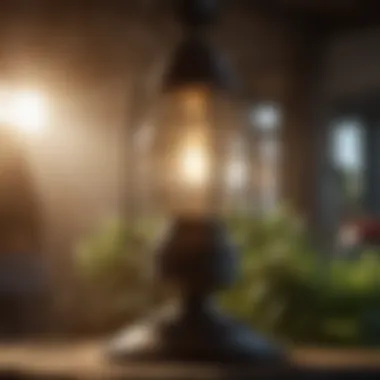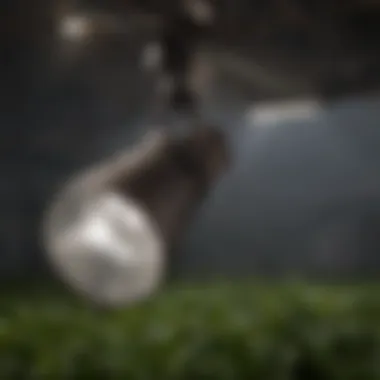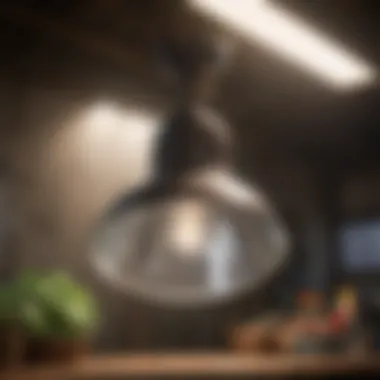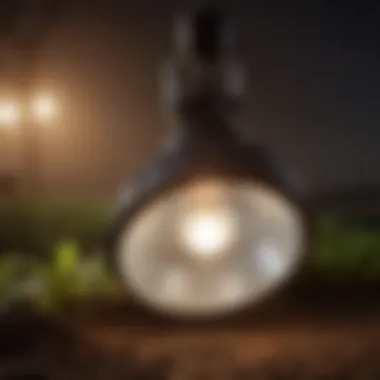Exploring 400 Watt Metal Halide Light Fixtures


Intro
When it comes to lighting solutions in agricultural and horticultural practices, the 400 watt metal halide light fixture stands out as a popular option among farmers and plant enthusiasts alike. These fixtures play a significant role in optimizing plant growth, especially in controlled environments like greenhouses. Understanding how these lights operate and their advantages in various applications can vastly improve crop yields and plant health.
Key Insights
Overview of the Topic
Metal halide lamps have been around for decades, becoming a staple in the indoor gardening and agriculture sector. Essentially, these lamps work by passing an electric current through vaporized metal salts, producing a bright white light that is highly effective for photosynthesis. This technology is particularly well-suited for growing plants that require high-intensity light.
As the demand for sustainable food production continues to rise, understanding the specifics of gas-discharge lighting, like the 400 watt metal halide, becomes equally important as mastering the soil or selecting the right species of plants.
Importance in Agriculture/Horticulture/Agronomy
Utilizing metal halide fixtures offers a range of benefits:
- Efficiency in Growth: These lamps emit a balanced spectrum of light, making them perfect for both vegetative and flowering stages of plant growth.
- Longevity: Metal halide bulbs typically last longer than their incandescent counterparts, which means less frequent replacements and lower operational costs.
- Environmental Adaptability: They are effective in various conditions, whether you’re growing in a temperate climate or a more controlled tropical environment.
Given these advantages, it's clear that integrating a 400 watt metal halide light fixture into agricultural practices can elevate productivity.
Sustainable Practices
Eco-Friendly Techniques
While the benefits are many, it’s vital to be mindful of sustainability when incorporating these fixtures. Employing energy-efficient practices is a must:
- Lighting Timers: Using timers can help reduce energy consumption by ensuring lights are only on when necessary.
- Reflection Techniques: Properly positioning fixtures using reflective materials can optimize light distribution while minimizing waste.
- Heat Management: Some plants thrive better when not exposed to excessive heat, so considering ventilation strategies is essential.
Case Studies on Sustainability
Examining operations that have incorporated these fixtures sheds light on their viability. For example, a mid-sized farm in California utilized 400 watt metal halide lights in their year-round tomato production. They found a marked increase in both quantity and quality of their tomatoes, leading to better market pricing. After a couple of years of monitoring, they reported reduced energy costs due to their efficient practices.
Tools & Resources
Essential Equipment and Technologies
To optimize the use of 400 watt metal halide light fixtures, consider these essentials:
- Ballasts: Ensure you select quality ballasts that match the fixture's specifications to prevent electrical issues.
- Reflectors: Installing reflectors can maximize light output while reducing glare.
- Light Meters: A light meter assists in measuring light intensity at plant canopy level, ensuring plants receive the appropriate amount of light.
Recommended Books and Readings
Those keen on understanding the science behind lighting in agriculture can delve into:
- The Greenhouse Gardener's Companion by Shane Smith
- Hydroponic Food Production by Howard M. Resh
- Indoor Gardening: A Complete Guide available on reddit communities
Each of these sources offers valuable insights and practical applications for utilizing metal halide technology in improving plant growth.
"The right amount of light can transform not just crops, but the entire agricultural landscape.`
Intro to Metal Halide Lighting
Understanding metal halide lighting is crucial for those involved in agriculture and horticulture. These fixtures play a significant role in optimizing plant growth by providing a spectrum of light that's closely aligned with natural sunlight. Moreover, the adoption of 400 watt metal halide fixtures can lead to effective energy usage, maximizing the potential in various growing environments.
Definition and Operation
Metal halide lights work by passing an electric current through a gaseous mixture of halide salts. These fixtures produce a bright white light that often resembles daylight. Unlike traditional incandescent lights, metal halide bulbs contain a unique blend of gases and metals, such as sodium, which, when energized, emit a broad spectrum of light. The operation of these fixtures relies on a ballast, which regulates the current and voltage to the lamp, ensuring stable performance.
The light generated is known for its ability to penetrate dense foliage, making it particularly useful in larger agricultural setups and greenhouse operations. Moreover, these fixtures typically have a longer lifespan compared to incandescent bulbs, which means they require less frequent replacements and maintenance.
Importance in Agriculture and Horticulture
The importance of metal halide lighting in agricultural contexts cannot be overstated. They are widely used in various growing environments for numerous reasons:
- Enhanced Growth Rates: Metal halide fixtures provide the full spectrum of light that plants need for photosynthesis, resulting in quicker growth rates and improved crop yields.
- Disease Control: The bright, intense light can deter some pests and diseases that thrive in low-light environments.
- Versatile Applications: These lights are effective not only in commercial greenhouses but also in indoor urban farms, effectively supporting plants from seedlings to maturity.


Anecdotal evidence from farmers suggests that switching to metal halide lighting systems can lead to marked improvements in overall yield and plant health. The ability to adjust placement and intensity further allows growers to tailor their lighting needs to specific plant varieties or growth stages.
"Switching to 400 watt metal halide lights has transformed our greenhouse; it feels like we brought the sun inside!"
— A satisfied greenhouse manager.
Specifications of Watt Metal Halide Fixtures
When diving into the realm of 400 watt metal halide light fixtures, it's crucial to understand their specifications. Each component—be it wattage, lumens output, or color temperature—plays a significant role in ensuring optimal growth for plants. These specifications set the foundation for how these fixtures can be employed most effectively in various agricultural and horticultural operations.
Key Technical Specifications
The technical specifications of a 400 watt metal halide light fixture provide detailed insights that inform users about the fixture's expected performance and capabilities. Here are some of the key elements:
- Wattage: As the name suggests, the fixture comes with a power rating of 400 watts, which balances energy consumption and light output adequately.
- Lumen Output: A standard 400 watt metal halide bulb typically produces approximately 36,000 to 45,000 lumens. This high output is instrumental in fostering photosynthesis and promoting plant growth.
- Color Temperature: Most metal halide bulbs emit light in the range of 3,200K to 4,200K. Such temperatures mimic natural sunlight, providing the blue spectrum that supports vegetative growth, making it perfect for different stages of plant development.
- Ballast Compatibility: These fixtures require a specific ballast to function properly. Magnetic or electronic ballasts can be used, influencing the efficiency and performance of the light. Knowing the right type of ballast can save you both energy and costs in the long run.
- Lifespan: Typically, metal halide bulbs have a lifespan of about 10,000 to 15,000 hours, depending on usage and maintenance. Regular checks can help extend this lifespan, signaling when replacements should be made.
Understanding these specifications ensures that growers choose the appropriate fixtures tailored to their unique circumstances, thereby optimizing light usage for plant health and yield.
Types of Bulbs Used
The world of 400 watt metal halide fixtures isn't all black and white; there are various types of bulbs that can significantly affect the outcome based on how they are employed. Below are the typical bulb options:
- Standard Metal Halide Bulbs: These are the most common and provide a strong blue spectrum, well suited for the vegetative stage of plant growth.
- High-Pressure Sodium (HPS) Conversion Bulbs: Although primarily HPS, these bulbs can be employed in metal halide fixtures with ballasts designed for dual use. They create a warm light beneficial for flowering phases.
- Ceramic Metal Halide (CMH) Bulbs: Offering better color rendering, CMH bulbs produce a more natural light spectrum, leading to healthier plants. They are known for their energy efficiency and improved lifespans compared to traditional types.
These varying bulb types cater to distinct agricultural needs, enabling flexibility and focused growth strategies. When growers understand the role of each bulb in relation to plant development, they can make informed decisions to enhance their agricultural outcomes.
Advantages of Using Metal Halide Lights
When it comes to effective horticultural practices, understanding the benefits of metal halide lights is crucial. This type of lighting brings several advantages that cater specifically to the needs of agricultural operations and horticultural activities. Below, we delve into the primary benefits associated with 400 watt metal halide lights.
Energy Efficiency Compared to Alternatives
Energy efficiency is a hot topic in agriculture, and rightly so. Metal halide lights have been known to offer better energy efficiency when stacked against traditional incandescent bulbs. While incandescents are notorious for converting a vast majority of consumed energy into heat rather than light, metal halide fixtures operate on an entirely different playing field.
- Reduced Electricity Consumption: Metal halide lights, especially at 400 watts, produce a significant amount of light per watt compared to their incandescent counterparts. They often provide more lumens for less wattage, translating to lower electricity bills.
- Longer Lifespan: When you consider the lifespan of a metal halide bulb, it is generally rated for 15,000 to 20,000 hours. This long-lasting nature reduces the need for frequent replacements, making it a cost-effective alternative. In contrast, traditional bulbs typically last around 1,000 hours.
These efficiencies play a pivotal role in the cost-effectiveness of using metal halide lights, especially for large-scale operations where every watt counts.
Color Rendering and Growth Enhancements
As any seasoned farmer knows, light quality plays a significant role in plant growth. The color rendering ability of metal halide lights is one of their standout features, making them an excellent choice for promoting healthy, robust plant growth. Let’s unpack this:
- Spectrum Distribution: Metal halide bulbs emit a full spectrum of light, which includes both blue and red wavelengths—vital for photosynthesis. The blue light aids in vegetative growth, while red light plays a crucial role during the flowering stage, helping plants to form fruit and seeds effectively.
- Color Rendering Index (CRI): Metal halide fixtures typically have a high CRI, translating to better color revealing. Plants exposed to full-spectrum lighting show better color expression, leading to healthier overall growth. This quality means plants not only flourish but also exhibit a more vibrant appearance, which can be a deciding factor for marketable produce.
In summary, metal halide lights are invaluable due to their energy efficiency and superior color rendering capabilities. Both aspects heavily influence decision-making for farmers looking to optimize their growing environments. By understanding these advantages, one can make more informed choices regarding lighting solutions, ultimately leading to enhanced productivity and profitability in agricultural endeavors.
"Optimizing light can be as important as watering—without it, growth stalls."
Applications in Different Growing Environments
The use of 400 watt metal halide light fixtures in various growing environments is a subject of growing significance, especially for those involved in agriculture and horticulture. These fixtures are not merely sources of light; they form the backbone of efficient growth strategies in indoor, greenhouse, and outdoor settings. The right lighting system can make the difference between thriving plants and disappointing yield, which makes understanding their applications crucial. This section delves into how these fixtures operate effectively in distinct environments, directing focus towards their adaptability, light quality, and energy use.
Indoor Growing Systems
Indoor growing is gaining popularity, especially for crops that require precise environmental controls. Metal halide fixtures shine in these settings, delivering intense, focused light that closely mimics natural sunlight. This characteristic is particularly beneficial for seedling stages, as many plants respond positively to the full spectrum of light these fixtures provide.
- Improved Growth Rates: The light emitted not only encourages vegetative growth but also supports flowering and fruiting phases in many types of plants. 400 watt metal halide lights help translate the energy captured into photosynthesis efficiently.
- Space Utilization: In indoor systems, space is often limited. The ability of metal halide lights to produce significant amounts of lumens allows for maximizing compact areas without sacrificing growth potential. This ensures that even the smallest gardens can flourish.
- Temperature Control: However, it’s crucial to monitor heat output. While metal halide lights produce robust light, they can also generate quite a bit of heat. Utilizing fans or air circulation systems can mitigate any potential overheating, creating a balanced environment for plants.
Greenhouses and Controlled Environments
When shifting our focus to greenhouses, the role of 400 watt metal halide lights becomes even more prominent. With the goal of extending growing seasons and improving crop yield, these fixtures effectively supplement natural sunlight fields during shorter days or cloudy spells.
"In a greenhouse, the synergy between natural light and artificial sources is vital for achieving optimal plant health."
- Supplemental Lighting: During autumn and winter months, when daylight shrinks, growers often rely on metal halide lights to offset the decrease in natural light. This not only supports plant growth but also sustains the photosynthesis process effectively, crucial for flowering and vegetable crops.
- Versatile Light Spectrum: These fixtures emit a range of light wavelengths, facilitating the diverse needs of different plant species housed together. Growers can adjust their lighting setup to address specific crop requirements for growth alternately, ensuring healthier plants and better harvests.
- Controlled Environment Impact: Integrating metal halide lights with temperature and humidity controls in a greenhouse can yield a more resilient cultivation environment. Adjusting nutrient delivery and watering routines in tandem adds another layer of efficiency that further enhances output.
Outdoor Use Cases


In certain outdoor situations, 400 watt metal halide lights can be deployed effectively as well. Although sunlight generally suffices, these fixtures provide support in specific circumstances such as temporary setups for special projects or installations.
- Emergency Lighting Solutions: During unexpected weather events or sudden frost periods, having a backup lighting system can safeguard delicate crops. Metal halide lights can help extend sunlight availability during these crucial survival times.
- Event Driven Uses: In many cases, outdoor markets, festivals, or garden shows might benefit from enhanced lighting, fostering vibrant displays that attract guests. This is where 400 watt metal halide lighting fixtures can set the mood and maximize visibility for both vendors and attendees.
- Aesthetic and Functional Benefits: Beyond pure function, these fixtures can enhance the aesthetic appeal of public gardens or parks, providing not just illumination but also a visual atmosphere. Proper distirbution and height adjustments assure it serves purposes while maintaining security and beauty.
In summary, the versatility and adaptability of 400 watt metal halide lights make them indispensable in various growing environments. From enhancing growth in indoor systems to offering supplemental lighting in controlled environments, as well as serving specific outdoor needs, understanding these applications empowers growers to maximize their investment and ultimately yield healthier crops.
Installation Considerations
When it comes to setting up a 400 watt metal halide light fixture, installation considerations underpin not just the efficiency of the lighting but also the overall growth success of the plants involved. Understanding these factors is important for optimizing light distribution, ensuring proper electrical compatibility, and mitigating potential hazards that can arise during setup. This section aims to lead you through the necessary steps and nuanced details that inform a successful installation, thereby aiding both experienced farmers and enthusiasts alike.
Site Assessment and Fixture Placement
Before any fixture can be hung or mounted, a thorough site assessment must be conducted. This fundamental step helps determine how much light is necessary based on your specific growing environment. Think of it as laying the groundwork before erecting a house. You wouldn’t build a strong foundation in a swamp, right?
- Light Coverage: Understand how much area each fixture will illuminate. A 400 watt metal halide lamp typically covers a specific diameter, which varies based on the height of placement.
- Height Considerations: The height at which you install the fixture affects light intensity. Generally, higher placements yield broader coverage but lower light intensity. Finding the sweet spot is crucial, so a balance must be struck based on the types of plants and their light needs.
- Reflective Surfaces: Evaluate the surrounding surfaces. Walls and ceiling colors can significantly affect light distribution. Lighter surfaces enhance light reflection, spreading it further, whereas darker surfaces absorb more, potentially resulting in uneven light.
- Ventilation Needs: Metal halide fixtures can generate substantial heat. Ensuring proper airflow around the fixture is vital for maintaining optimal temperatures. Installing cooling systems or ensuring the fixture is high enough to prevent heat stress on plants could save you a lot of headaches later on.
"A good light installer understands not just the fixture, but the environment it will inhabit".
Electrical Requirements
Now that you have a grasp of where to place your fixtures, electrical requirements should be your next stop. After all, the most glorious light fixtures won't do much if they aren't adequately powered.
- Voltage Compatibility: Ensure that your metal halide fixture matches the voltage of your electrical system. Most 400 watt fixtures operate on standard 120V or 240V systems, but a mismatch can lead to failure or even fire hazards.
- Wiring Assessments: Conduct a thorough check of existing wiring. It should be rated to handle the power requirements of the installation. Underestimated capacity can lead to overheating and, in extreme cases, electrical fires. If in doubt, consult an electrician for a professional assessment.
- Ballast Requirements: Metallic halide lamps necessitate a ballast to regulate the electrical current flowing to the bulb. Understanding which ballast suits your fixture is paramount. Magnetic and electronic ballasts have different output efficiencies and control mechanisms.
- Safety Protocols: If you’re overseeing the installation yourself, adopt all necessary safety protocols. This includes turning off electrical supplies before making any connections and ensuring that moisture doesn’t intrude on your electrical setup, potentially shorting out your equipment.
As you navigate the installation of your metal halide fixtures, keep a detailed checklist handy. That way you can ensure you’re not overlooking any aspect, maximizing the potential of your lighting system for a fruitful harvest.
Maintenance and Lifespan
The longevity and efficiency of 400 watt metal halide light fixtures hinge significantly on proper maintenance. A fixture that remains well-maintained not only performs optimally but also extends its operational life, which is essential for any serious grower. Given that these lights are often a substantial investment, understanding both maintenance practices and the signs of wear is invaluable for maximizing their utility.
A few core elements to consider include routine upkeep, proactive checks for any parts showing signs of age, and scheduling replacements when necessary. These practices not only ensure consistent light output but also help in avoiding costly downtimes. In cultivating an environment that demands precision, such diligence pays off with healthier plant growth and ultimately, increased yields.
Routine Maintenance Practices
Regular maintenance routines can drastically prolong the lifespan of metal halide fixtures. Here are key actions growers could incorporate into their maintenance schedule:
- Cleaning: Accumulated dust and grime can block light output. A soft cloth with a mild detergent solution can work wonders for lenses and reflectors. Regularly wipe down these surfaces at least once a month.
- Check Electrical Connections: Before each growing season, inspect cords and connections for any signs of wear or fraying. Loose or damaged connections can lead to electrical failures.
- Bulb Replacement: Metal halide bulbs gradually lose their effectiveness, often within a year of usage. Monitoring hours of use can indicate when replacements are due. It's recommended to replace bulbs annually for optimal performance.
- Cooling System Care: Overheating can drastically shorten a fixture's lifespan. Regularly check fans if present, and ensure that they are free from debris. This small act can go a long way in maintaining a safe operating temperature.
Adhering to these practices not only enhances performance but also fosters a safer growing environment. Just like an engine needs oil changes, metal halide fixtures demand attention to operate at their best.
Signs of Deterioration and Replacement
Recognizing when a metal halide fixture is nearing the end of its useful life can save growers from unexpected costs. Here are some signs to watch for:
- Diminished Light Output: If you notice that your fixture is not illuminating as brightly as it once used to, it could be a signal that the bulb is nearing the end of its lifespan. Reduced lumens can seriously hamper plant growth.
- Flickering Light: A flickering light can indicate not just bulb issues, but potential problems with ballast or electrical connections. Attention to this detail is critical, as ignoring it can lead to further complications.
- Color Shift: Metal halide bulbs should emit a crisp, white light. An increased yellow or orange tint suggests the bulb may need replacement soon.
- Unusual Noises: Any strange sounds coming from the fixture should raise red flags. Buzzing or crackling sounds can be a precursor to serious electrical issues.
- Heat Emission: If the fixture is excessively hot to the touch, it may indicate that something is wrong, perhaps with its cooling system or fan.
Being vigilant about these signs aids in anticipating maintenance needs before they impact your crops. Proactive measures will help maintain an effective growing environment and prevent interruptions typically caused by failures.
Proper care transforms your fixtures from simple tools into dependable partners in horticulture.
By prioritizing routine maintenance and being aware of deterioration signs, growers can ensure their 400 watt metal halide fixtures continue to illuminate their gardens efficiently.
Environmental Considerations
Considering the environmental impact of lighting solutions, particularly the 400 watt metal halide fixtures, is essential in today's world. Farmers and horticulturists alike are increasingly aware that their choices can either promote sustainability or lead to unintended consequences. Recognizing this, examining two core areas—energy consumption and the disposal of metal halide bulbs—can shed light on how these fixtures fit into an eco-conscious framework.
Impact on Energy Consumption
When we talk about energy consumption, metal halide lights do pack a punch, and not in a good way. They typically consume more power compared to some modern alternatives such as LEDs. Despite their high light output and broader spectrum, their inefficiency raises eyebrows. Farmers must consider whether the high initial wattage translates into the energy efficiency they truly desire.
- The energy use of 400 watt fixtures generally leads to higher electricity bills.
- They do have a long-lasting lifespan, but the initial cost of running them can undermine those savings.
- Switching to lower wattage LED lights can result in significant long-term savings.
While using these fixtures effectively, growers should keep an eye on the overall electrical requirements of their setups. This awareness can lead to smarter energy management, impacting their carbon footprint positively.
Recycling and Disposal of Metal Halide Bulbs


After serving their purpose, the journey of metal halide bulbs doesn't just end with disposal. Proper recycling and disposal are critical, considering that these bulbs contain materials that can pose environmental risks if not managed correctly.
- Mercury is a key component in metal halide bulbs, which can release harmful substances into the environment if broken or improperly disposed of.
- Collection methods like drop-off centers or mail-in programs become essential for environmentally responsible disposal.
- Raising awareness regarding the hazardous waste regulations that govern the disposal of such bulbs is crucial for growers.
Farmers can often feel overwhelmed with regulations, but familiarity with local disposal laws can save headaches down the road. Taking the necessary steps to recycle metal halide bulbs not only honors the environmental ethos but also fosters a sustainable growing practice.
"Proper disposal of metal halide bulbs is not just a responsibility; it is a commitment to the environment."
Comparative Analysis with Other Lighting Solutions
In the realm of agricultural lighting, selecting the right lighting solution holds immense significance. ;Understanding how 400 watt metal halide fixtures stack up against other lighting options is vital for growers looking to optimize their production and energy use. This comparison will highlight essential elements such as energy efficiency, light spectrum quality, and operational costs. By scrutinizing other types of lighting, farmers can make better-informed decisions tailored to their specific needs.
Incandescent vs. Metal Halide
When comparing incandescent and metal halide lights, the contrast becomes stark almost immediately. Incandescent bulbs have been around for eons, known for their warm glow and easy availability. However, they are notoriously inefficient. They convert a significant amount of energy into heat rather than light. In this respect, metal halide fixtures take the cake. They produce a much brighter light with a more useful spectrum for plant growth while generating less heat. This means less energy wasted and potentially lower cooling costs.
Here are a few key points to consider:
- Efficiency: Metal halide bulbs typically operate at around 90 lumens per watt, in contrast to incandescent lamps which only manage about 15 lumens per watt.
- Lifespan: While incandescent bulbs might last roughly 1,000 hours, metal halide lights can last up to 15,000 hours, making them a more durable investment.
- Light Quality: Metal halide lights provide a full spectrum of light, which is crucial for plant growth. Incandescent lights fall short in this department, offering limited spectrum that’s not particularly beneficial for cultivating plants.
"In the gardening world, the choice of light can be a game changer. It's not just about brightness but quality too."
LED Alternatives
On the other side of the spectrum lie LED lights, which have gained tremendous traction lately among growers. They are celebrated for their ultra-low energy consumption and versatility. Although metal halide fixtures excel in certain areas, LEDs are not without their merits.
Here’s how they compare:
- Energy Consumption: LEDs are among the most efficient lights available today, often consuming 50% less energy than metal halide bulbs while delivering equivalent or better light outputs.
- Heat Emission: LEDs produce significantly less heat, which can lead to further savings on climate control, especially in indoor or greenhouse settings.
- Service Life: The longevity of LEDs can reach up to 25,000 hours, surpassing metal halide lifespan, but at a higher initial purchase price.
Still, metal halide lights do well when considering specific applications such as large-scale operation setups where intense lighting is necessary, or where the light spectrum closely mimics sunlight is crucial.
User Experiences and Case Studies
In the realm of 400 watt metal halide light fixtures, real-world insights from both professional farmers and hobbyist growers are paramount. They offer relatable perspectives that underscore the practical implications of these lighting systems. Understanding these experiences paves the way for a more informed approach to utilizing these fixtures effectively for optimal growth and productivity.
Professional Farmers’ Insights
Professional farmers often invest substantial resources into their grow operations. The effectiveness of lighting can significantly influence crops’ yield, quality, and growth rate.
Farmers who have implemented 400 watt metal halide fixtures report several critical touchpoints:
- Yield Improvements: Many have noted that these lights facilitate enhanced crop quality, leading to a richer color and taste in produce than other traditional options. For instance, in growing tomatoes or cucumbers, farmers see a visible boost in classifying their crops as premium products.
- Energy Management: Energy costs remain a considerable concern for many growers. Farmers weighing the operational costs against the benefits of metal halide lighting often find that the gradual increase in yield offsets the initial energy usage. While it might not be the most efficient option on the market today, it serves as a capable middle ground, especially in settings where crops require a specific light spectrum for proper growth.
- Customization: Different growing stages require different light intensities. Many professionals adapt their use of 400 watt fixtures, adjusting the distance from plants as they mature. This flexibility can optimize growth cycles tailored to individual crop needs, which helps better fulfill planting schedules.
"When I switched to metal halide lights, I didn’t expect the type of quality I’d see. My yields are not just heavier; they’re better too!" – A satisfied farmer from Illinois.
Hobbyist Perspectives
For hobbyist growers, who often work with smaller setups, whether indoors or in backyards, the experience with 400 watt metal halide lights leans toward versatility and exploration. Here are some noteworthy observations:
- Compact Growth Spaces: Hobbyists utilize these fixtures in personal gardens or mini-greenhouses, capitalizing on the ability to grow year-round. The 400 watt system often produces enough light intensity to facilitate photosynthesis, even on cloudy days or during winter months.
- Experimentation with Varietals: Many hobbyists enjoy testing various plants, from herbs to exotics. The feedback from these experiments often highlights that metal halide lights help achieve satisfactory growth without necessitating complicated setups. Growers report that they’ve had notable success with leafy greens and flowering plants, attributing this success to the favorable light spectrum provided by the fixtures.
- Cost Efficiency: Initially, the cost of energy is an essential factor for hobbyists. Some have adapted their use of metal halide lights to cheaper alternatives, like LED, arguing that while metal halide systems are less efficient, they provide a specific ambiance and experience, especially for those who love gardening as a passionate hobby.
In summary, user experiences from both ends of the spectrum provide a rich tapestry of information that might aid future buyers. Farmers adjust their methodologies according to the unique attributes of their crops, and hobbyists experiment without overly complex technology. As a result, understanding these insights is vital in determining the right application in varying growing environments.
Culmination and Future Directions
In summing up the various insights explored throughout this article, it’s clear that 400 watt metal halide light fixtures are pivotal for growers who aim for optimal plant development in both agricultural and horticultural applications. As we transition into a future characterized by technological advances, understanding the significance of these light fixtures becomes paramount. Their role extends beyond mere illumination; it encapsulates energy efficiency, growth optimization, and environmental considerations. Each element discussed contributes to a holistic approach needed to maximize the benefits of metal halide lighting.
Summary of Key Takeaways
As we wrap things up, let’s distill the essence of what we’ve covered:
- Essential Functionality: Metal halide lights offer remarkable efficiency, crucial for extensive lighting needs.
- Versatility: Suitable for various environments, whether it’s commercial agriculture or small-scale hobbyist setups, their adaptability is valuable.
- Seasoned Insights: Feedback from professional farmers and hobbyists illustrates the tangible benefits observed, such as improved crop yield and enhanced growth rates.
- Maintenance Importance: Regular upkeep ensures longevity, which aids in cost management over time.
- Future Potential: With emerging technologies, metal halide fixtures might evolve, incorporating enhanced spectrums or integration with smart systems.
Summarizing, these fixtures ought to be seen through a strategic lens, as part of a comprehensive grow lighting plan.
Emerging Technologies in Grow Light Systems
Looking forward, the landscape of grow light systems is shifting, driven by innovation and sustainability efforts. As existing technologies evolve, several emerging trends demand attention:
- LED Integration: Many growers are exploring hybrid systems that combine the benefits of metal halide with LED technologies. This hybrid approach can result in energy savings while maintaining a high-quality light spectrum.
- Smart Technologies: The integration of IoT (Internet of Things) within grow light systems is on the rise. This means growers can manage lighting conditions remotely and adjust based on real-time data, leading to tailor-made growing scenarios.
- Spectral Tuning: Advances in spectral tuning allow for finer control over the light spectrum emitted, which can be customized based on the specific requirements of various plants at different growth stages.
- Sustainability Focus: As awareness of environmental impact rises, technologies that minimize energy use and improve recyclability of components are garnering interest from growers and manufacturers alike.
In summary, as we delve deeper into the specifics of grow light systems in general, one must remain keenly aware of the possibilities that lie ahead. The interplay of metal halide technology with modern advancements may redefine its place in horticultural practices, shaping a sustainable future.







